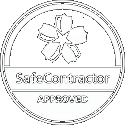Artificial grass is simple to install, but it can very easily go wrong when an inexperienced installer decides to install without consulting the installation guide first. In this article, we highlight several common mistakes to avoid when installing your new artificial lawn.
At this point, you might be wondering whether you can install artificial grass yourself, which, of course, you can. The most difficult part of the installation is preparing the area. Laying the turf is the simple bit, providing you read our fitting instructions. Read our DIY installation page for a complete guide to a perfect installation.

#1 Groundwork Mistakes
Not getting the groundwork stage correct is only going to result in a poor installation as you need to lay a strong foundation for your grass. The key to getting this right is to take a good look at the area to be covered by artificial turf and confirm a few things before starting work:

What base are you using?
The perfect base for your artificial grass is MOT1 granite stone compacted roughly to a contoured shape of the lawn. This is finished off with 6mm dust granite stone which, once wet and compacted, provides a smooth, firm base for the turf.
Does the area drain freely?
If not, then a drainage pit may need to be fitted to allow adequate drainage. This is simple enough and can be easily installed when laying the groundwork. Ensuring the area drains sufficiently will prevent pooling water, flooding, and moss growth and make sure your artificial lawn stays low-maintenance.
Do you have a preferred method to hide the edge of the artificial grass?
You need to install the edge of the artificial grass into a perimeter to create an attractive finish. This edge could be VertEdge, one of the best edging for artificial grass, paving slabs, decking, or a gravel board separating a planting border. The grass should be set approx 20mm the height of the perimeter edge for the best look.
Do you have any obstructions that may need to be modified, for example, a drain cover?
If you have any obstructions, this won’t be a problem as the groundwork can be contoured to match the required height to create an even and level surface and make installation much more convenient. For example, you may need to work around a manhole where the grass can be recessed to allow future access.

Are there moles or rats in your garden?
To ensure you don’t have problems with your new artificial lawn, it’s important to consider any history of moles digging in the garden or rat burrowing causing the lawn to sink. This will need to be resolved before work starts and can be solved in various ways including installing a barrier around the lawn perimeter.
Does your garden have Japanese knotweed?
Japanese knotweed is a serious problem to consider before installing your lawn as it can shift and heave the turf. Also, using equipment on a lawn with knotweed can cross-contaminate the next lawn it is used on. Japanese knotweed can be difficult to remove but should be eliminated before beginning your lawn project.
#2 Joint Mistakes
One of the most common mistakes when installing artificial grass is not getting joints correct. There is no secret to jointing artificial grass, it simply requires patience and know-how. We go into more detail about how to complete a joint here. Common joint mistakes can be broken down into three main groups:
i) Too Much Adhesive
Be careful not to use too much adhesive on the jointing tape or near the jointing gap. This can cause the adhesive to ooze out when pressing down each section. To fix this, use a brush cleaner on a clean white rag to remove the adhesive. If the adhesive is not removed, sand and dirt will stick to it and it will show up after the installation is complete.

ii) Using Salvage as Joint Tape
If you joint the grass using the black salvage edge of the roll, it will only guarantee a poor joint. The salvage is not designed to be used as a jointing method. If you look closely, you will see that the latex backing covers the back of the artificial grass tufts but does not extend over the salvage.
This can be an issue because as it goes through the backing plant it shrinks at a greater rate than the backed grass which, in turn, can hold ripples along the side of the artificial grass. Once this salvage is removed, the grass drops flat, giving a fault-free surface. Also, using the salvage edge means the tufts have not been cut back to provide a new clean edge, which is required to try to achieve a perfect joint.

iii) No Clean Edges
Not cutting back the edges for a joint is tempting if the roll has no salvage. (The salvage is left on to protect the ends of the roll so has to be removed to expose a clean edge for joining).
Just as important as removing salvage is removing a few rows of tufts if the roll has no salvage. This is because the ends of the rolls can get slightly damaged during shipping and crushed when wrapped. Although this is normal, it still requires the edge to be cut back to ensure a clean line.
The procedure is simple. Firstly, roll the grass out in position and fold along the joint. Then count in 3-4 tufts and cut along the gap between the rows. Doing this on both sides will give a clean, perfect join. If on review when you stand back and it’s not 100% then take a couple more rows of tufts off and try again.


Cut back 3-4 rows of tufts to get the best joint.
#3 Folding and Fixing Over Timber Edges
Folding and fixing artificial grass to a timber frame is a common mistake for DIY installers and even so-called ‘experts’. Thankfully it does appear this incorrect practice is not as common as it once was. Timber frames for artificial grass can cause many problems for your new lawn, the most serious being groundwork settling while the frame stays at its original height.
Over time, the groundwork inside the timber frame will settle, resulting in ripples along the edges and, in worst cases, causing the grass to rip along the timber edges, which would be a potential trip hazard.
Other reasons not to fix over timber battens are more for aesthetic reasons, including:
- Folding the artificial grass over the timber will open the pile, leaving an ugly edge exposed.
- Timber-framed artificial lawns are restricted to being square and flat as it’s difficult to curve or follow the contours of the garden.
- Artificial grass nailed to the upright of timber edging looks very unnatural and will not do the grass justice.
#4 Not Sand Infilling
Over the years, the question of whether artificial lawns need sand infilling has been up for discussion many times. The simple answer is that almost all artificial lawns require sand infill. The common reason for DIY installers not using sand is to cut the costs of installation and reduce installation time. Sadly, there are still companies that don’t infill with sand and short-changing end users.
Read our expert DIY guide to learn how to sand infill your artificial lawn.
Benefits of Sand Infill
- The sand acts as a stabilising agent that holds the grass in place and allows it to follow the contours of your garden lawn, giving a real-looking result.
- It keeps the artificial grass lawn cool during the summer and stops the expansion of the grass in the hottest months.
- Sand infill protects the grass from sharp objects, dog claws, vandalism, play equipment and garden furniture feet.
- Although our artificial grass is not flammable (and has been tested to BS4790, which is the same test for household and office carpets), sand infill acts as a natural fire retardant to help reduce damage from garden accidents. However, remember that artificial grass is plastic and will melt in extreme temperatures or open flames, so we recommend informing your home insurance provider of this.
#5 Choosing the Wrong Grass
This mistake occurs before you have even stepped into the garden. When choosing which grass is right for you, don’t simply hold the samples in your hand and let only this inform your choice. For example, the softest-feeling synthetic turf will not offer the same resilience as a slightly hardier grass.
One way to aid your decision is to lay each sample on your current lawn, stand back (and even look out the bedroom window), to see which blends into the real grass best. What you might be surprised to find is that the grass you dismissed as too bright or too dark is actually a perfect match!
Also, ask your installer for advice on each product, as they have experience in fitting the products and can advise the pros and cons depending on your wants and needs. View our range of premium artificial grass products here, get your free artificial grass samples here, and contact us today for expert advice on which is the best artificial grass product for you.
Artificial Grass Installation
Follow these tips to ensure you do not make the same artificial lawn installation mistakes. If you are planning to install artificial grass yourself, feel free to call our technical department with any questions you may have or read our DIY guide for step-by-step instructions on everything from completing a joint to sand infilling.
However, if learning about all the possible mistakes you can make when installing your artificial lawn has put you off the idea of doing it yourself, we can do the hard work for you. We have a network of installers across the UK who are trained to install artificial grass to the highest standard. Get in touch today for your free site survey*.
Get a Free Site Inspection
Have your potential artificial grass installer come in and inspect the space, making sure they take into account drainage of the lawn, garden access, lawn edges and any obstructions. Always ask for an itemised quote for all the steps of the installation – see our artificial lawn quote example here. This way, you know that the day of the installation won’t end with a nasty surprise.












